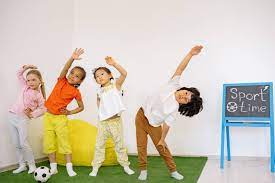1. Hula Hoops: These classic toys not only help improve physical coordination, but also encourage outdoor play and burning energy.
2. Jump Ropes: Great for developing coordination, balance, and endurance, jump ropes are a versatile and fun way to get kids moving.
3. Sidewalk Chalk: Encouraging creativity, sidewalk chalk can be used for drawing, hopscotch grids, and more, providing hours of fun.
4. Soccer Balls: Kids can learn teamwork and develop their gross motor skills while playing soccer.
5. Frisbees: Frisbees are perfect for developing hand-eye coordination, making them a great addition to any outdoor games collection.
6. Playground Balls: Perfect for kickball or other ball games, these balls encourage physical activity and team-building skills.
7. Tug-of-War Rope: This simple yet effective game helps build both teamwork and upper body strength.
8. Gardening Tools: Encourage kids to learn about plants and the environment by providing child-sized gardening tools including shovels, rakes, and watering cans.
9. Bubbles: Simple yet mesmerizing, bubbles are an excellent way to keep younger children entertained outside while also helping to develop their fine motor skills.
10. Scooters: Scooters promote balance and coordination while providing endless fun as kids zip around the neighborhood.
11. Trampoline: Teachers love trampolines for building strength, balance and promoting an active lifestyle.
12. Pogo Sticks: These bouncy toys help build gross motor skills as well focus and determination as kids try to hop as many times as possible.
13. Water Table: A fantastic sensory play opportunity that allows kids to explore water properties such as sinking or floating while engaging in a group activity.
14. Obstacle Course Kit: Let the kids set up their own obstacle course, helping them improve their problem-solving skills and motor coordination.
15. Chutes and Ladders: A large outdoor version of this popular board game is perfect for teaching counting and number recognition.
16. Bean Bag Toss: A classic game that helps develop gross motor skills, hand-eye coordination, and patience.
17. Balance Beam: This playground staple improves balance and coordination while also building core strength.
18. Sandboxes: Perfect for sensory play, sandboxes can keep kids entertained for hours while they build their fine motor and creative thinking skills.
19. Velcro Paddleball Set: This simple yet fun game helps develop coordination while providing a great way to engage kids in outdoor play.
20. Croquet Set: Teach kids the basics of this quintessential outdoor game while working on their fine motor skills and strategic thinking abilities.
21. Parachute Games: Perfect for large groups, parachute games help teach cooperation, coordination, and timing skills.
22. Kites: Flying kites is an excellent way to get kids outside, teach them about wind and weather patterns, and work on their coordination skills.
23. Scavenger Hunt Kit: Encourage exploration and discovery with a pre-made scavenger hunt kit or create your own using natural items found outdoors.
24. Bocce Ball Set: Bocce is an easy-to-learn game that promotes strategy, precision, and teamwork among players.
25. Butterfly Nets: Inspire young naturalists by providing butterfly nets for them to explore the wildlife in their backyard or nearby parks.








